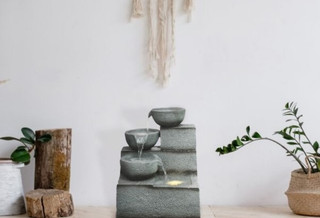Whether you’re looking design advice for your garden or you’re interested in learning more about the history of these meditative spaces, we’ve got you covered with our best tips and tricks.
What is a Zen Garden?
In recent years, many people have enjoyed creating their own backyard Zen gardens, as these meditative spaces are known for their relaxing and calming effect. Since many people have become accustomed to spending more time at home in recent years, it’s more important than ever to create a comfortable and rejuvenating space at home.
Although there are many well-known aspects of this meditation space, there are no specific rules to follow when creating one in your own backyard. In contemporary design, many homeowners enjoy incorporating these relaxing elements into their existing outdoor area, allowing for endless customization.
How to Make a Zen Garden
Before getting started, it’s important to choose the perfect location for your garden space. Whether you choose and area the front, side, or back of your yard, you’ll need to take precise measurements of the area. Not only will these measurements assist you when purchasing your supplies, but you’ll need to understand the general layout of your yard before designing and customizing the meditation space. If you’re looking for advice when choosing an area, we suggest a dry, flat, and landscaped area for a simple installation process.
After choosing the desired location for your Zen garden, you’ll need to gather a few tools and supplies. Most Zen gardens incorporate white gravel as a base for the design, along with rocks and stones of various shapes and sizes. You’ll also want to consider investing in a garden or Zen rake, along with some landscape fabric and additional décor. Although plants are not required, many Japanese gardens often incorporate these natural elements. A few of our favorites include horsetail, ferns, and bamboo.
What Does a Zen Garden Look Like?
Ideas for a Peaceful Space
Zen gardens are quite helpful for those looking to add some relaxation and mindfulness to their lifestyle. These spaces are most effective when placed in quiet areas, as the listener can relax in the garden and enjoy the sounds of water and nature. These spaces are most effective when placed in quiet areas, as the listener can relax in the garden and enjoy the sounds of water and nature without distraction. In order to make the most of your meditation space, you’ll want to avoid placing your garden near a busy road or highway. If you have the option, many designers enjoy placing the garden in an area that is visible from inside the home for an exceptional view.
For a personalized touch, you’ll also want to consider displaying your plants in stylish garden planters. Not only do these planters allow you to show off your unique style, but they provide a simple and efficient upkeep process when maintaining your garden. With high-quality garden planters from Hanover, you’ll enjoy a perfect blend of style and durability. Ideal for both small and large spaces, garden planters from Hanover provide you with long-lasting controlled spaces to grow your plants with ease.
Elements and Personalizing a Patio
When creating a Zen garden, it’s important to consider each component of your garden as a symbol of natural elements. As white gravel often represents the movement of the ocean, rocks usually symbolize mountains, but they can also act as a symbol of strength. Additionally, water often plays an important symbolic role in Zen gardens, acting as a symbol of purification and cleansing. You’ll want to consider including an element in your space that represents water, both for it’s deeper meaning and relaxing noise.
If you’re looking for unique ways to include water elements in your design, garden fountains are an excellent addition to any meditation space. With a variety of beautiful designs available from Hanover, you’ll experience the ultimate Zen oasis with the tranquil sound of flowing water.
